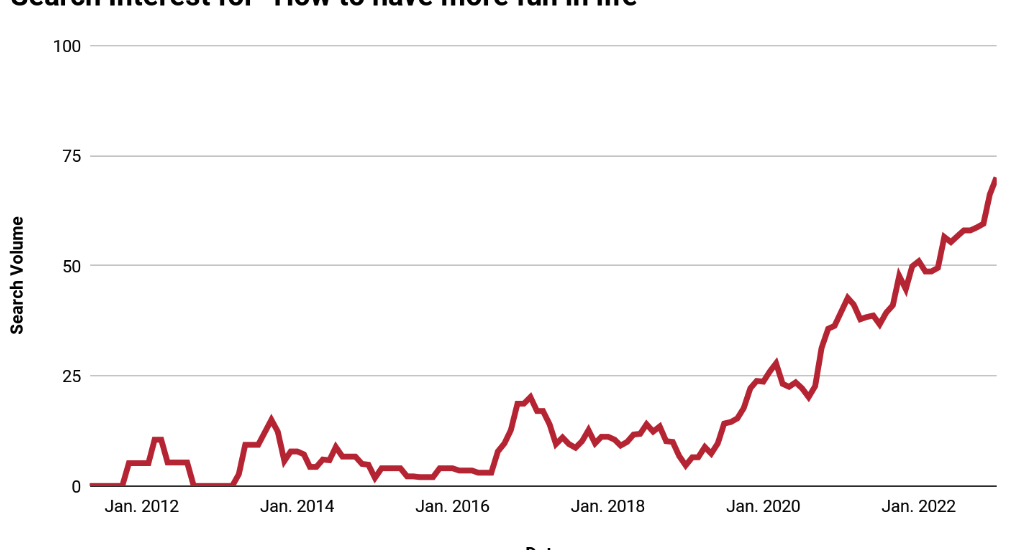Let’s face it, we could all do with a little lighthearted fun once in a while.
Last June, I and the Trends team discovered that adults were increasingly searching what we called “kidding around terms:” like “fairytale bedrooms for adults,” “adult pigtails,” and the funny list continued.
As it turns out, the party was just getting started: from our follow-up research, we’re seeing consumers continue their search for positivity and jubilance. And, brands are taking notice. Here are three trends we’ve been watching in the “joyconomy” space.
3 Joyconomy Trends to Watch
1. Playful Brand Expansions
Over the past two years, brands have tweaked their offerings, brand expansions, and campaigns to encourage optimism and childlike abandon. For example:
When McDonald’s introduced Happy Meals for adults in late 2022, total sales rose by roughly 10%. Meanwhile, half the limited-edition toys were gone in the first four days.
Shortly after, Moxy Hotels’ Manhattan branch launched their Playful Stays to offer “endless amusements enlivened with the spirit of the absurd.” Amenities included game rooms, pinball arcades, dress-up items, and Instagram-worthy decor.
How can you leverage similar tactics?
If you’re an entrepreneur with more time and control over your brand, you could also rebrand offerings traditionally focused on children, or introduce playfulness through product experience — like Seth Rogan’s cannabis brand Houseplant, which recently unveiled new collectible, Lego-like packaging (this one is clearly only for adults).
But, you don’t need to reinvent the wheel, know a celebrity, build a large-scale rebrand, or own a big company to provide people with moments of fun and emotional release.
Simply creating funny or positive social media content or commentary could do the trick, as we discovered in our most recent consumer trends survey.
2. Social Platforms Prioritizing Positivity
Yes, social media comes with a LOT of negativity these days. And, a lot of platforms will do the opposite of creating joy. But, here us out.
Just when you think the market is saturated with negative, duplicative social media channels, a new entrant comes along, knocks it out of the park, and demonstrates a new vibe we can all consider digging into.
The most recent winner? A social positivity app for teens.
Gas, which allows users to anonymously compliment each other, launched late last August. By the following October, it had hit the top spot on the App Store (beating even TikTok), and by December it had reached 10m downloads and $6 million in sales.
Less than six months after launch and boasting a grand total of four team members, Gas was acquired by Discord.
This focus on social positivity is echoed by new community app Niche, hot off a $1.8-million pre-seed raise. Users join close-knit social clubs around shared identities or interests, and clubs are often centered on positivity — like Hit of Happiness.
So far reviews are as positive as the app’s experience.
More than ever, consumers are clearly looking for positive modes of engagement, intimacy, and support online. People want to feel a sense of belonging that current platforms (Facebook, Instagram) just can’t offer.
While brand strategists can continue to keep positive platforms (and the trends emerging on them) on their radar, entrepreneurs could compete directly with niche social platforms, designed around positivity and uplift, for specific markets like seniors or the LGBTQ+ community.
3. Joy-First Product Offerings
A great example of a brand that prioritized the “joyconomy” on social media is athleisure brand JoJa, which has a strong social presence built on motivating and positive content and recently launched a community-focused exercise app.
JoJa’s new platform aims to foster intimacy by gathering like-minded individuals who can bond over shared workouts, beauty tips, and nutrition advice. Members can also unlock exclusive JoJa clothing discounts by completing fitness challenges.
They aren’t the only activewear brand jumping on the playfulness and community trends.
Set Active just launched a “community-driven” brick-and-mortar store, inspired by childhood field trips to museums, as well as a Community Collection, which features designs chosen by fans.
Meanwhile, Psychologist Kelly McGonigal put a simple — yet positive spin on the much-seen fitness business model by launching the Joy Workout, which includes movements scientifically shown to elicit positive emotions (like bounces, sways, jumps, and a move McGonigal calls “celebrate,” which mimics tossing confetti).
Joining in on the fun is Pony Sweat, an ’80s-style dance fitness company that champions “anti-perfectionism and radical self-acceptance.”
They’ve seen their Instagram following more than double since 2020, and have since launched virtual class options and a community Discord server.
Start Engaging Happy Audiences
Ultimately, brands don’t have to open physical stores or develop their own app to give intimate community building, or positive motivation a go. They just need a bit of creativity, and — ideally — interests in making their audience jump for joy.
Editor’s Note: This piece was originally published in Trends’ Premium Newsletter and was recently edited, updated, and adapted for the HubSpot Blog.





